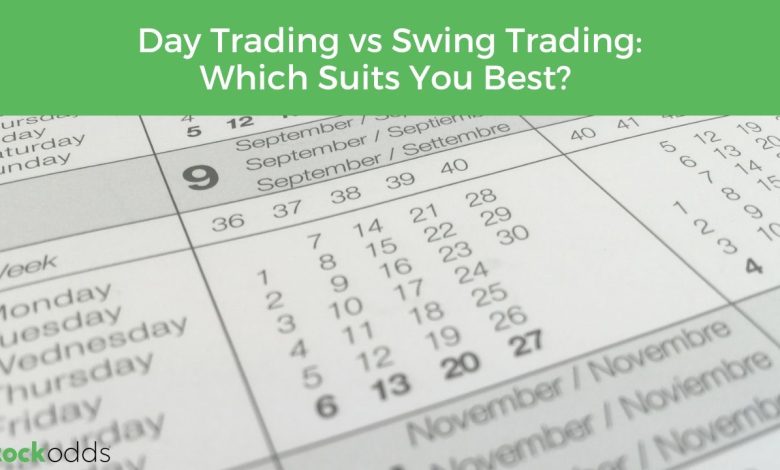Swing Trading vs. Day Trading: Which is Right for You?

- Understanding the differences between swing trading and day trading
- Pros and cons of swing trading
- Pros and cons of day trading
- Factors to consider when choosing between swing trading and day trading
- Strategies for successful swing trading
- Strategies for successful day trading
Understanding the differences between swing trading and day trading
When it comes to trading in the stock market, it’s essential to understand the differences between swing trading and day trading. While both strategies involve buying and selling financial instruments, they differ in terms of the time frame in which trades are executed.
Day trading involves buying and selling securities within the same trading day. Day traders aim to capitalize on short-term price movements and typically close out all positions before the market closes. This strategy requires a high level of focus and attention throughout the trading day.
On the other hand, swing trading involves holding positions for several days to weeks. Swing traders aim to capture larger price movements and are not as concerned with intraday fluctuations. This strategy allows for more flexibility and less time commitment compared to day trading.
One key difference between swing trading and day trading is the level of risk involved. Day trading can be more risky due to the fast-paced nature of the market and the potential for significant losses in a short period. Swing trading, on the other hand, allows for more time to analyze trades and make informed decisions, which can help mitigate risk.
Ultimately, the choice between swing trading and day trading depends on your trading style, risk tolerance, and time commitment. Some traders may prefer the excitement and quick profits of day trading, while others may find the more relaxed pace of swing trading to be a better fit. It’s important to carefully consider your goals and preferences before deciding which strategy is right for you.
Pros and cons of swing trading
When considering swing trading, it is important to weigh the advantages and disadvantages of this trading strategy. Here are some pros and cons to keep in mind:
- Pros:
- 1. Less time-consuming: Swing trading typically involves holding positions for a few days to a few weeks, allowing traders to have more flexibility and not be tied to their screens all day.
- 2. Less stressful: Unlike day trading, swing trading does not require constant monitoring of the markets, which can help reduce stress levels.
- 3. Potential for higher profits: Swing traders aim to capture larger price movements compared to day traders, which can result in higher profits if done correctly.
- 4. Less market noise: By focusing on longer timeframes, swing traders can avoid some of the market noise that can impact shorter-term trades.
- Cons:
- 1. Overnight risk: Holding positions overnight can expose swing traders to overnight risk, such as gap openings that can result in significant losses.
- 2. Less action: Swing trading may not be suitable for traders who thrive on the fast-paced action of day trading, as positions are typically held for longer periods.
- 3. Requires more patience: Swing trading requires patience to wait for the right setups to develop, which may not appeal to traders looking for quick profits.
- 4. Higher capital requirements: Since swing traders aim to capture larger price movements, they may require more capital to enter and exit positions compared to day traders.
Ultimately, whether swing trading is right for you will depend on your trading style, risk tolerance, and time commitment. It is important to carefully consider the pros and cons before deciding which trading strategy aligns best with your goals and preferences.
Pros and cons of day trading
Day trading has its own set of advantages and disadvantages that traders should consider before deciding if it is the right strategy for them.
- Pros:
- **Flexibility**: Day trading allows traders to be more flexible with their trading strategies and adapt to market conditions quickly.
- **Quick Profits**: Traders can make quick profits by taking advantage of short-term price movements in the market.
- **No Overnight Risk**: Since day traders close out their positions before the market closes, they do not have to worry about overnight risk.
- **High Potential Returns**: Day trading offers the potential for high returns if done correctly.
- Cons:
- **High Risk**: Day trading is inherently risky, as traders are exposed to market volatility and price fluctuations throughout the day.
- **Time-Consuming**: Day trading requires a significant time commitment, as traders need to monitor the market closely throughout the trading day.
- **Emotional Stress**: The fast-paced nature of day trading can lead to emotional stress and decision-making under pressure.
- **High Costs**: Day trading can be costly, as traders may incur high fees and commissions from frequent trading.
Factors to consider when choosing between swing trading and day trading
When deciding between swing trading and day trading, there are several factors to consider that can help you determine which approach is right for you. It’s essential to weigh these factors carefully to make an informed decision that aligns with your trading goals and risk tolerance.
One factor to consider is the time commitment required for each trading style. **Day trading** typically involves actively monitoring the markets throughout the day and making quick decisions based on short-term price movements. On the other hand, **swing trading** allows for more flexibility as trades are held for several days to weeks, requiring less time in front of the screen.
Another factor to consider is the level of risk associated with each trading style. **Day trading** can be more volatile and unpredictable due to the short-term nature of the trades, while **swing trading** may offer more stability as it focuses on capturing larger price movements over a longer period.
Additionally, it’s essential to consider your trading capital and risk management strategy. **Day trading** often requires a larger capital base to take advantage of small price fluctuations, while **swing trading** can be more accessible to traders with limited funds as it involves fewer trades with larger potential gains.
Furthermore, your personality and trading preferences should also play a role in your decision-making process. If you thrive in a fast-paced environment and enjoy making quick decisions, **day trading** may be more suitable for you. On the other hand, if you prefer a more relaxed approach and have the patience to wait for trades to play out, **swing trading** could be a better fit.
In conclusion, the choice between swing trading and day trading ultimately depends on your individual circumstances and preferences. By considering factors such as time commitment, risk tolerance, capital requirements, and personal trading style, you can determine which approach aligns best with your goals and objectives in the market.
Strategies for successful swing trading
When it comes to successful swing trading, there are several strategies that can help traders maximize their profits. One key strategy is to focus on technical analysis to identify trends and patterns in the market. By using tools such as moving averages, support and resistance levels, and chart patterns, traders can make more informed decisions about when to enter and exit trades.
Another important strategy for successful swing trading is to manage risk effectively. This means setting stop-loss orders to limit potential losses and sticking to a trading plan to avoid making impulsive decisions. It’s also crucial to diversify your trades and not put all your capital into one position.
Additionally, staying informed about market news and events can help traders anticipate potential price movements and adjust their strategies accordingly. By keeping up to date with economic indicators, earnings reports, and geopolitical developments, traders can stay ahead of the curve and make more profitable trades.
Lastly, it’s essential for swing traders to be patient and disciplined. Markets can be volatile, and it’s important not to let emotions dictate trading decisions. By sticking to a well-thought-out strategy and being patient for the right opportunities, traders can increase their chances of success in the long run.
Strategies for successful day trading
When it comes to day trading, there are several strategies that can help increase your chances of success. Here are some key tips to keep in mind:
- Develop a solid trading plan: Before you start day trading, it’s important to have a clear plan in place. This plan should outline your goals, risk tolerance, and the strategies you will use to make trades.
- Stay disciplined: Day trading can be fast-paced and volatile, so it’s crucial to stay disciplined and stick to your trading plan. Avoid making impulsive decisions based on emotions.
- Manage risk effectively: Risk management is essential in day trading. Make sure to set stop-loss orders to limit potential losses and only risk a small percentage of your trading capital on each trade.
- Use technical analysis: Day traders often rely on technical analysis to identify trading opportunities. Learn how to read charts and use indicators to make informed decisions.
- Stay informed: Stay up to date on market news and trends that could impact your trades. Being informed can help you make better decisions and react quickly to market changes.
By following these strategies and staying disciplined, you can increase your chances of success in the world of day trading.



